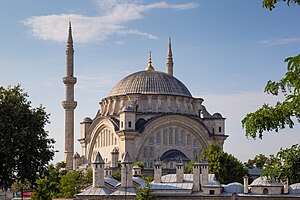Clockwise from top: Nuruosmaniye Mosque (1748–1755); Sebil of the Mihrişah Sultan Complex (1792–1796); Mausoleum of Mustafa III at the Laleli Mosque (1760–1764) | |
| Years active | 1740s to 1820s |
|---|---|
Ottoman Baroque architecture, also known as Turkish Baroque,[1][2] was a period in Ottoman architecture in the 18th century and early 19th century which was influenced by European Baroque architecture. Preceded by the changes of the Tulip Period and Tulip Period architecture, the style marked a significant departure from the classical style of Ottoman architecture and introduced new decorative forms to mostly traditional Ottoman building types. It emerged in the 1740s during the reign of Mahmud I (1730–1754) and its most important early monument was the Nuruosmaniye Mosque, completed in 1755. Later in the 18th century, new building types were also introduced based on European influences. The last fully Baroque monuments, such as the Nusretiye Mosque, were built by Mahmud II (r. 1808–1839) in the early 19th century, but during this period new European-influenced styles were introduced and supplanted the Baroque.
- ^ Hartmuth, Maximilian (2009). "Eighteenth-century Ottoman architecture and the problem of scope: a critical view from the Balkan 'periphery'". In David, Géza; Gerelyes, Ibolya (eds.). Thirteenth International Congress of Turkish Art: Proceedings. Budapest: Hungarian National Museum. p. 298.
- ^ Rüstem 2019, p. 6.


